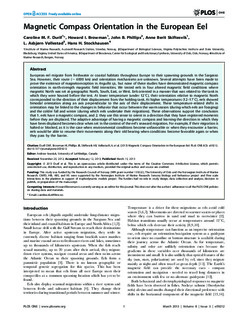| dc.contributor.author | Durif, Caroline M.F. | |
| dc.contributor.author | Browman, Howard I. | |
| dc.contributor.author | Phillips, John B. | |
| dc.contributor.author | Skiftesvik, Anne Berit | |
| dc.contributor.author | Vøllestad, Leif Asbjørn | |
| dc.contributor.author | Stockhausen, Hans Hagen | |
| dc.date.accessioned | 2013-04-10T07:08:46Z | |
| dc.date.available | 2013-04-10T07:08:46Z | |
| dc.date.issued | 2013-03-15 | |
| dc.identifier.citation | Durif CMF, Browman HI, Phillips JB, Skiftesvik AB, Vøllestad LA, et al. (2013) Magnetic Compass Orientation in the European Eel. PLoS ONE 8(3): e59212. | no_NO |
| dc.identifier.issn | 1932-6203 | |
| dc.identifier.uri | http://hdl.handle.net/11250/109286 | |
| dc.description.abstract | European eel migrate from freshwater or coastal habitats throughout Europe to their spawning grounds in the Sargasso Sea. However, their route (~ 6000 km) and orientation mechanisms are unknown. Several attempts have been made to prove the existence of magnetoreception in Anguilla sp., but none of these studies have demonstrated magnetic compass orientation in earth-strength magnetic field intensities. We tested eels in four altered magnetic field conditions where magnetic North was set at geographic North, South, East, or West. Eels oriented in a manner that was related to the tank in which they were housed before the test. At lower temperature (under 12uC), their orientation relative to magnetic North corresponded to the direction of their displacement from the holding tank. At higher temperatures (12–17uC), eels showed bimodal orientation along an axis perpendicular to the axis of their displacement. These temperature-related shifts in orientation may be linked to the changes in behavior that occur between the warm season (during which eels are foraging) and the colder fall and winter (during which eels undertake their migrations). These observations support the conclusion that 1. eels have a magnetic compass, and 2. they use this sense to orient in a direction that they have registered moments before they are displaced. The adaptive advantage of having a magnetic compass and learning the direction in which they have been displaced becomes clear when set in the context of the eel’s seaward migration. For example, if their migration is halted or blocked, as it is the case when environmental conditions become unfavorable or when they encounter a barrier, eels would be able to resume their movements along their old bearing when conditions become favorable again or when they pass by the barrier. | no_NO |
| dc.description.sponsorship | This study was funded by the Research Council of Norway [NFR grant number 159222], The University of Oslo and the Norwegian Institute of Marine Research. CMFD, HIB, ABS, and HS were supported by the Norwegian Institute of Marine Research: Sensory biology and behaviour project and Fine scale interactions in the plankton in support of trophodynamic models project. The funders had no role in study design, data collection and analysis, decision to publish, or preparation of the manuscript. | no_NO |
| dc.language.iso | eng | no_NO |
| dc.publisher | Plos One | no_NO |
| dc.title | Magnetic Compass Orientation in the European Eel | no_NO |
| dc.type | Journal article | no_NO |
| dc.type | Peer reviewed | no_NO |
| dc.subject.nsi | VDP::Agriculture and fishery disciplines: 900::Fisheries science: 920::Fish health: 923 | no_NO |
| dc.source.pagenumber | 7 s. | no_NO |
| dc.source.journal | PLoS ONE | no_NO |
| dc.identifier.doi | 10.1371/journal.pone.0059212 | |
| dc.relation.project | NFR grant number 159222 | no_NO |
